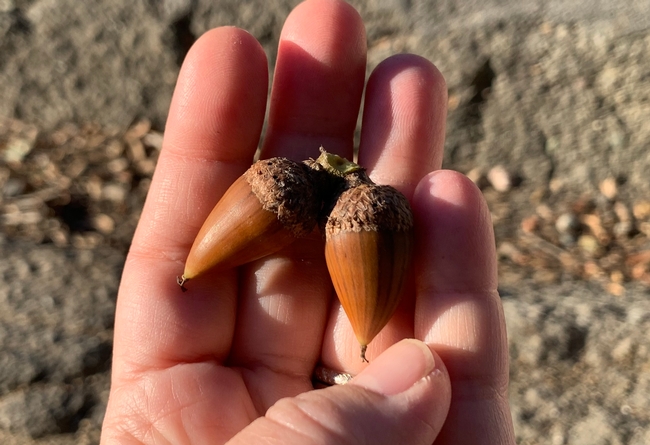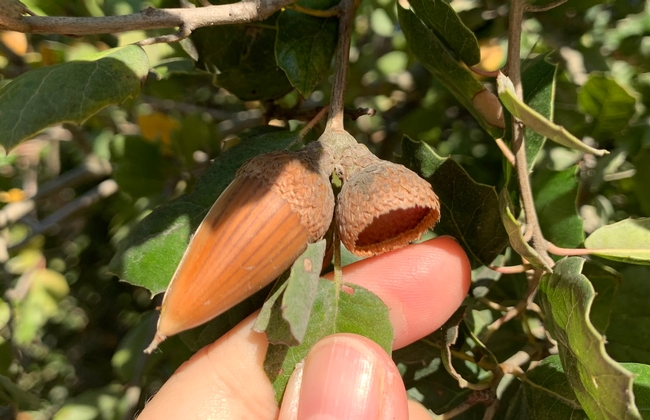
In the Fall, acorns start falling from oak trees. You may notice some acorns germinating and little seedlings forming, usually in inconvenient spots. But as stewards of the environment, you may wonder if it's possible to successfully transplant them to grow into strong oaks in more convenient locations. In this article, we'll cover acorn collecting for planting and transplanting seedlings. (Photo: Acorns in good condition, which can be planted or saved for later planting. (Photo by: Michelle Chin)
Saving acorns for planting
In terms of saving the acorns, you can definitely save them to plant at a later date. The best time to collect them is in the Fall. The San Luis Obispo Master Gardener program recommends the following tips.
- Save acorns that are brown with caps that can easily come off. Discard any acorns that are damaged, small, or feel hollow.
- You can test acorns by soaking them in water for 24 hours. Discard the ones that float.
- To store acorns, make sure they're dry, remove their caps, and place them in a plastic sandwich bag in the refrigerator. They should be kept cold at around 40°F to slow growth activity. You can store them for up to 6 months. Before planting, test to see if any acorns float. Discard any that float. The ones that sink are good for planting.

Acorns are ready when they're brown and they separate from their caps easily. (Photo by: Michelle Chin)
Alternatively, if you don't want to store them, you can plant acorns during the rainy season of November-March.
Before you collect acorns, ensure you have permission from the property where you're collecting them.
Planting acorns
Plant acorns anytime between November and March, during the rainy season. Planting acorns earlier in the season is better because it gives them more time to grow. This also reduces potential problems with premature germination during storage.
Where to plant acorns
- If you're planting directly in the ground, plant acorns in a sunny spot with loose, well-draining soil. Also, consider if there are any power lines above or below, underground sewer, water, or gas lines, or nearby buildings (home, garage, etc.). You'll want to avoid planting in these areas. Also, consider how big a mature oak tree can get. For example, a Coast Live Oak (Q. agrifolia) can become 20-70 feet tall!
- Dig a hole using a hand trowel or shovel. We recommend digging a hole several inches deeper than you'll actually plant the acorn, then partially fill the hole back up with loosened soil. This will make it easier for the seedling's roots to grow.
- If you're planting in a container, use well-draining soil and place the containers in a sunny spot.
How to plant acorns
- Plant the acorns ½-1” below the soil surface.
- If the acorns have germinated, be careful not to break the root tip. Position the acorn so the root tip is pointing down.
- Plant ungerminated acorns on their side and cover them with soil.
- Water the acorns after planting. If rain isn't consistent, water them once a week.
- Depending on the type of oak tree, germination can take a few weeks.
Transplanting oak seedlings
It's possible to transplant seedlings successfully. Here are a few tips.
When to plant oak seedlings
December through February is an excellent time to transplant seedlings because the soil will likely be wet.
Where to plant oak seedlings
- Plant seedlings in a sunny spot with loose, well-draining soil.
- Also, consider if there are any power lines above or below, underground sewer, water, or gas lines, or if they're near a building (e.g., home, garage, etc.). You'll want to avoid planting in these areas.
How to plant oak seedlings
- When digging up the seedling, try to keep intact as much as possible of the soil around it.
- Prepare the area you'll want to plant the seedling. Weeds, grasses, and other plants can remove resources from the seedling. Clearing an area of 2-3 feet around where the seedling will go will prevent that competition. You can clear the area by scraping the surface of unwanted plants. Adding mulch to that surface will suppress weeds and prevent other plants from taking over.
- The planting hole needs to be deep enough so that its roots don't bend upward when you plant the seedling.
- Digging a deeper hole (1-2 feet deep with an auger) can help root development and tree growth. This is helpful if the soil is compacted and hard. If you plan on digging a deep hole, call (811) or submit a ticket online (USANorth811.org) to have the area inspected for any underground utility lines.
- Plant the seedling so the soil it came with is level with the ground of its new home. Planting it too low or too high can impact its success. Tamp the soil around the seedling and water thoroughly.
- You can add some fertilizer to the hole before transplanting to promote growth.
- If there isn't much rain, watering periodically will help establish the seedling in its new home.
- Seedlings make great snacks for critters (and lawnmowers), so if that's a threat, creating some sort of cage or covering will help. You can make a cage from wire and place it around the seedling, but household materials like large yogurt containers or cardboard work just as well.
Here are additional resources if you'd like to learn more about growing oaks and oak trees in California.
- Master Gardeners of San Luis Obpiso's article on Oak Tree Care (PDF): https://ucanr.edu/blogs/slomggarden/blogfiles/13336.pdf
- UC Oaks article on How to Grow California Oaks: https://oaks.cnr.berkeley.edu/how-to-grow-california-oaks/ (If you go to the main home page of the site, there's a lot more information on oaks!)
- Oaks in the Urban Landscape by L. Costello, B. Hagen, K. Jones, a UCANR book
- How to Grow California Oaks by D. McCreary, a UCANR publication (PDF)
If you try planting acorns, let us know by reaching out to us on social media. We're on Instagram and Facebook at @alamedaMG.